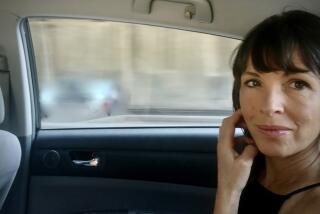Kosinski Minus the Sins : THE HERMIT OF 69TH STREET The Working Papers of Norbert Kosky <i> by Jerzy Kosinski (Seaver Books / Henry Holt: $19.95; 527 pp.) </i>
- Share via
It is impossible to say anything about Jerzy Kosinski that he hasn’t already said about himself, and said better. Kosinski’s ninth novel approaches the world from a dizzying, mystical, word- and world-drunk point of view. His narrator, the driver of his self-declared “autofiction,” is an emigre Polish writer significantly named Norbert Kosky. An inveterate practitioner of Joycean punning and feverish wordplay, certainly the author intends for us to recognize that “Kosky” is “Kosinski” minus the “sins.” Is this the novel as expiation?
Sin and redemption, the spiritual life of the writer in exile, the ethical desiderata of the post-Holocaust Jew, are among the hundreds of subjects Kosinski takes on in the “Hermit of 69th Street: The Working Papers of Norbert Kosky.”
In an ironically straightforward preface, Kosinski tells us that he found the novel, the working papers of Norbert Kosky, on “Nostromo , an unassuming fishing junk.” If this novel is anything, it is not unassuming.
Kosky is a spiritual friend of Kafka, of Bruno Schulz, of Nabokov, and especially, of Conrad, those great Eastern European moderns who shared his exile. Interestingly, he also feels a strong kinship for such distinctly American writers as Thomas Wolfe and James Fenimore Cooper. For, as we come to realize, any writer--or artist, or historical figure--who has suffered rejection or public disgrace, or been misunderstood by his audience, becomes a subject of active sympathy for Kosky/Kosinski.
Why finally is Kosky/Kosinski so concerned with questions of public shame and scandal, plagiarism and imitation, influence and art? And how are these issues bound up with the apparently separate questions of copy editing, proofreading, translation and traduction?
It is not possible to answer these questions or finally, to understand the novel completely, without knowing quite a bit about Kosinski’s real life. In his penchant for exhibitionism, his randy narcissism, Kosinski often reminds us of that other great advertising man, Norman Mailer. If Mailer’s weak spot is his consuming (and silly) love for Marilyn Monroe, Kosinski’s is his inextinguishable romance with himself.
In 1982, Eliot Fremont-Smith and Geoffrey Stokes co-authored a shattering article in the Village Voice in which they responded to years of accumulated rumors about Kosinski’s work and life. Among other things, Fremont-Smith and Stokes alleged that Kosinski’s use of copy editors, editors and proofreaders dangerously exceeded a writer’s ordinary employment of such professionals.
Their controversial claim--that in some important sense Kosinski was not the sole author of his own words--created a literary scandal of far-reaching consequence. This book, then, this apologia disguised as a novel, the self-revealing and self-disguising life on paper, “The Hermit of 69th Street,” is Kosinski’s passionate and often brilliant response to that scandal.
The special features of this novel--its dense modernist language, its aim at public apology, its metafictional complexity, its “shameless” use of quoted material--from texts as diverse as Newsweek and the Cabala, obscure girlie magazines and the writings of Erasmus--all conspire to make “The Hermit” as solipsistic, as finally Hermetic, as its hero.
Kosinski is not only indulging himself in private jokes and flamboyant autobiography. He is also writing a novel far more ambitious and unusual than the eight novels that came before. A patently experimental novel, “The Hermit” shares many characteristics of the great modernist works of the century.
Like Joyce and Nabokov, Kosinski is a lover of language, a writer who gets his hands dirty, who likes to feel the grit and textures of words under his nails. Sometimes his incessant punning becomes an irritating verbal tic: “It must have belonged to Glorious Gloria, his latest proofreader in transit, who slept with him in his office last night but since she did not last long (sick transit Gloria mundie) remains legitimately tax-deductible.”
Sometimes the self-consciousness of his prose and the strangeness of his metaphors strike the reader as forced: “Our mini-Baudelaire blocks her path like a persistent human semicolon found on the steps of a colonnade.”
Sometimes, Kosinski’s cinematic segues strike us as convincingly unsettling and bizarre, mimetic of the strange discordances and dissonances of modern life. Such an odd but meaningful transition occurs, for example, when Kosinski aborts a learned discussion of the Jewish rite of circumcision to give us a footnote explaining that Uncut: the Magazine of the Natural Man “explores every facet of the uncircumcised man with . . . lavish photo layouts . . . the most beautiful magazine in history devoted to foreskin.”
In a transition such as this, Kosinski takes us from the sublime to the sleazy, from covenant to concupiscence, in a matter of seconds. He asks us to consider not only the terrific dysphoria of modern life--its restlessness, its displacement of the godly with the transitory, its blurring of all civilizing distinctions, but also to consider the consequences of the fall of man, the opportunities for redemption.
Finally, I believe that Kosinski is interested in the fall of man and not only in his own fall from a “ ‘first-rate second-rate novelist’ ” (as Kosky describes himself on the “David Mailman TV Show”) to an exposed Polish Jew, a mere emigre, once again suspected of trading on false papers.
Kosinski is genuinely interested in Adam’s fall, as well as his own. For this is above all else, a book of moral seriousness. If it shares some of the problems of all would-be masterpieces--grandiloquence, a tendency to overreach itself, the textures of a text rather than a book--it is also an earnest attempt to take on the big questions, the brave if quixotic task for the 55-year-old author of 12 previous books (including two works of nonfiction written under a pen name).
Second-rate or first-rate, meshuggener or prophet, Kosinski at mid-career provides original entertainment, plenty of laughs and, for the reader willing to uncode his riddles and foot his footnotes, an education and copyright law, Tantric sex, the Holocaust, pornography and everything else you ever wanted to know about Kosinski but were afraid to ask.
More to Read
Sign up for our Book Club newsletter
Get the latest news, events and more from the Los Angeles Times Book Club, and help us get L.A. reading and talking.
You may occasionally receive promotional content from the Los Angeles Times.







